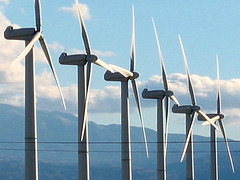 Encouraging advances is solar power technology from the US DoE’s National Renewable Energy Laboratory:
Encouraging advances is solar power technology from the US DoE’s National Renewable Energy Laboratory:
Scientists at the U.S. Department of Energy’s National Renewable Energy Laboratory (NREL) have set a world record in solar cell efficiency with a photovoltaic device that converts 40.8 percent of the light that hits it into electricity. This is the highest confirmed efficiency of any photovoltaic device to date.
But:
The 40.8 percent efficiency was measured under concentrated light of 326 suns. One sun is about the amount of light that typically hits Earth on a sunny day.
Mmm. I wonder what the efficiency will be under normal conditions (once it’s mass produced)? Still, it’s pretty impressive as a proof of concept:
…the new design uses compositions of gallium indium phosphide and gallium indium arsenide to split the solar spectrum into three equal parts that are absorbed by each of the cell’s three junctions for higher potential efficiencies.
Beautiful. Kudos to humanity’s glorious electrical engineers!
[story here via ElectricalEngineer.com and KurzweilAI.net][image from Alex // Berlin on flickr]

 By burning cheap and widely available coal but storing the resultant carbon dioxide rather than venting it into the atmosphere means you (theoretically) have a cheap and low-carbon energy source.
By burning cheap and widely available coal but storing the resultant carbon dioxide rather than venting it into the atmosphere means you (theoretically) have a cheap and low-carbon energy source.